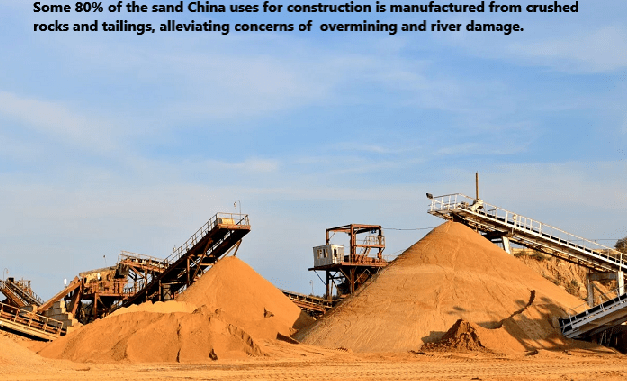
Between 80 to 90 per cent of the sand used in China’s construction industry today is manufactured, marking a turning point in human engineering and offering hope to solve a major crisis for the world, according to a new study.
Sand has been used in buildings for at least 60,000 years. It is the second most used resource on earth after water. Rapid population growth and urbanisation in recent decades have accelerated the depletion of natural sand reserves.
The United Nations Environment Programme (UNEP) estimates that 50 billion tonnes of sand and gravel – stones larger than sand – are extracted for construction every year, enough to build a wall 27 metres wide and 27 metres high around the planet.
Crushing rocks into sand: rising costs push China to manufacture artificial components for cement
China – where the urbanisation rate has soared from 17 per cent to 58 per cent over the past four decades – is particularly hungry for sand. The UNEP warned that the world might soon run out of sand resources because of the huge demand from rapidly developing countries, including China .
“We cannot extract 50 billion tonnes per year of any material without leading to massive impacts on the planet, and thus on people’s lives,” UNEP researcher Pascal Peduzzi told the BBC in 2019.
However, according to a recent study published in the journal Nature Geoscience, China’s overall sand supply – which increased by about five times between 1995 and 2020 – comes mostly from man-made sand, which is produced by mechanically crushing and sieving rock or mine tailings.
The study was a collaboration between international researchers from institutes that include the Research Centre for Eco-Environmental Sciences under the Chinese Academy of Sciences, Leiden University in the Netherlands and the University of Cambridge in Britain.
The team built a dynamic monitoring system, known as “material flow analysis”, and found that China’s sand supply patterns “fundamentally shifted” over the study period, with the dominant source shifting from natural sand to manufactured sand, which grew rapidly at an average annual rate of 13 per cent and surpassed natural sand after 2011.
By contrast, natural sand supply increased rapidly from 2000, peaking in 2010, and declining since then. In 2020, the proportion of natural sand compared with total sand supply stood at only around 21 per cent – down from around 80 per cent in 1995.
It represents a landmark in the history of human civil engineering, especially considering that China’s sand consumption is an outstandingly high percentage of global use.
In the absence of accurate data on global sand mining and use, cement production is usually used as an alternative method of estimation, as the raw material for construction is cement, water, sand and gravel. According to available UNEP data, China alone accounted for almost half of global cement production in 2012.
Song Shaomin, a professor at Beijing University of Civil Engineering and Architecture who was not involved in the study, said he was not very surprised by the findings. He said the percentage of manufactured sand in the Chinese market could now be close to 90 per cent.
Song said that driven by unprecedented urbanisation and economic development of the world’s largest developing country, especially since 2010, China’s natural sand reserves had been drying up and the price of sand has been rising, prompting the construction industry to seek an alternative source: manufactured sand.
Machine-made sand production started to thrive when the government tightened the regulation of sand mining in rivers in 2016. Illegal sand mining was targeted that same year after an environmental protection inspection group led by ministerial-level officials was set up.
Since then, regulations and strict policies have been put in place to restrict natural sand mining. Medium and large construction aggregate production lines have sprung up to meet market demand in a greener and cheaper way, Song said.
At present, two or three suppliers along the Yangtze River have an annual production capacity of 70 million tonnes or more, a capacity that ranks among the top five in the world.
“The shift from natural sand to manufactured sand is a miracle for a country that has completed such massive infrastructure construction, and a must for China’s high-quality development,” Song said.
The sustainable use of sand has become a global focus in recent years, as it is not only a resource issue, but sand mining could also pose environmental threats such as riverbank erosion, loss of biodiversity and deterioration of water quality if left unregulated.
“China’s practice provides a reference to the transition to alternative sand supplies for the world,” the authors say, adding that mitigating the impact on natural sand resources during industrialisation and urbanisation was possible.
Source: South China Morning Post, Aug 12, 2024. https://www.scmp.com/news/china/science/article/3273891/china-builds-manufactured-sand-easing-worry-about-overmining-and-environmental-cost